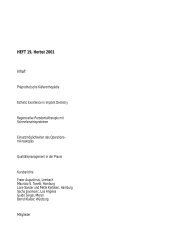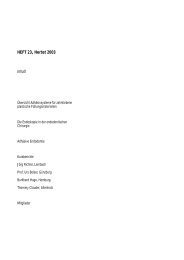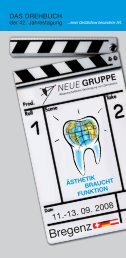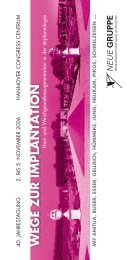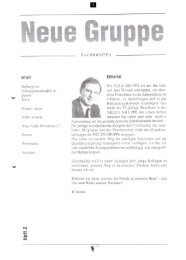KONTROVERSEN IN DER PARODONTOLOGIE - Neue Gruppe
KONTROVERSEN IN DER PARODONTOLOGIE - Neue Gruppe
KONTROVERSEN IN DER PARODONTOLOGIE - Neue Gruppe
Sie wollen auch ein ePaper? Erhöhen Sie die Reichweite Ihrer Titel.
YUMPU macht aus Druck-PDFs automatisch weboptimierte ePaper, die Google liebt.
<strong>KONTROVERSEN</strong> <strong>IN</strong> <strong>DER</strong><br />
<strong>PARODONTOLOGIE</strong><br />
Konsequenzen für die Praxis<br />
Freitag, 18. 11. 2005 • 9.15 – 10.15 Uhr<br />
Prof. Dr. Leonardo Trombelli<br />
Associate Professor and Chair, Periodontology and Implantology, School of Dentistry, University<br />
of Ferrara. Director of Dental Hygiene School, University of Ferrara. Director of the Research<br />
Center for the Study of Periodontal Diseases, University of Ferrara. President Elect of the Italian<br />
Society of Osseointegration. Active member of the Italian Dental Association, Italian Society<br />
of Periodontology, Italian Society of Osseointegration, International Association of Dental<br />
Research, and International Academy of Periodontology. Editorial Board member for the<br />
Journal of Clinical Periodontology and Perio. Author of numerous publications in international<br />
journals. Private practice limited to Periodontology and Implantology.<br />
Füllermaterialien in der Parodontologie – ist ein Vorteil gegenüber<br />
dem alleinigen Membranverfahren zu erwarten ?<br />
Deep intra-osseous defects represent a major challenge for the clinician. Sites with intraosseous<br />
lesions have been shown to be at higher risk of disease progression in subjects who<br />
had not received systematic periodontal therapy. Reconstructive procedures have been used<br />
with varying success during the past decades to accomplish the restitutio ad integrum of lost<br />
attachment apparatus in deep intraosseous defects. One of the most investigated method to<br />
achieve the reconstruction of intraosseous defects is to combine the access surgery with the<br />
placement of bone grafts or implant biomaterials into the debrided bony lesion with the goal<br />
to regenerate the lost periodontal tissues. Grafting biomaterials include autogenous grafts,<br />
allogenic grafts, xenogenic grafts and alloplastic materials. The assumption behind the clinical<br />
use of GPs is that the complete regeneration of the attachment apparatus (including new<br />
bone formation and new connective tissue attachment) would be enhanced by the various<br />
biomaterials due to their osteogenetic potential (if the graft would contain viable bone- forming<br />
cells), osteinductive capacities (exerted by the release of bone-inducing substances), or<br />
osteoconductive properties (i.e. the possibility to create a scaffold to support bone formation).<br />
Overall, observational and controlled trials have generally reported an additional benefit in<br />
terms of soft and hard tissue improvements following the use of GPs. However, due to the<br />
large variety of graft biomaterials proposed on the market, the magnitude of such improvements<br />
as well as the consistency of the advantage achieved when GPs are compared to an<br />
access flap procedure need to be determined yet. The presentation will focus on the effect<br />
of the use of grafting procedures in addition to conventional open flap debridement in the<br />
treatment of deep intraosseous defects. Specific advantages of the grafting procedures when<br />
compared to membrane-supprtive reconstruction will also be analyzed.<br />
<strong>IN</strong>TENSIVSEM<strong>IN</strong>AR Sonntag, 20. 11. 2005 • 9.00 – 13.00 • Saal 16<br />
Parodontalchirurgie: wann resektiv, wann regenerativ ?<br />
Wenn regenerativ, welche Methode bringt die größten Vorteile ?<br />
Abstract siehe S. 30<br />
13




